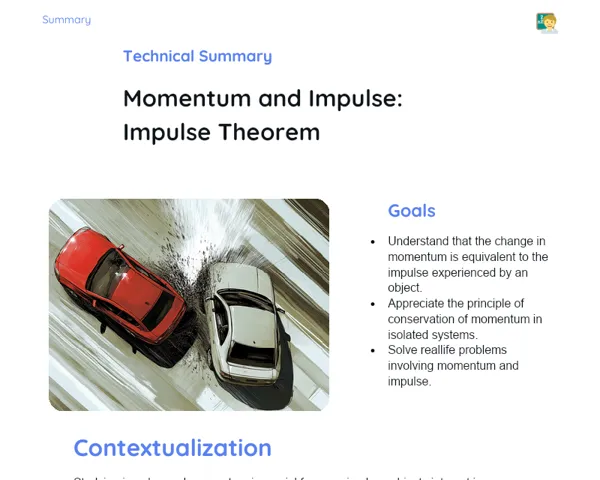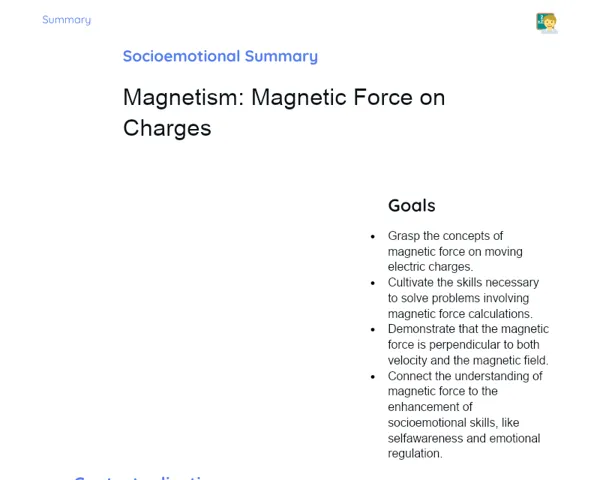Summary Tradisional | Electricity: Capacitors in Series
Contextualization
Capacitors are vital components in today's electronic devices, playing an essential role in storing and releasing electrical energy efficiently. From everyday gadgets like calculators to more complex systems such as computers and communication equipment, capacitors are used everywhere. Grasping how capacitors function and interact in various setups is key to mastering electrical circuits and electronics.
A frequently encountered setup is the configuration of capacitors in series. Here, the capacitors are linked in a way that ensures the electric charge remains constant across each component, while the total voltage in the circuit is split among them. This arrangement has unique traits that affect the overall capacitance of the circuit, and comprehending these traits is important for calculating equivalent capacitance—a fundamental skill for addressing practical challenges and enhancing electronic circuit performance.
To Remember!
Definition of Capacitors
Capacitors are devices that store electrical energy as an electric field. They comprise two conductive plates, called electrodes, which are separated by an insulating material known as a dielectric. The primary role of a capacitor is to collect and release electric charge as required, making it an indispensable part of numerous electronic circuits.
Capacitors are favored in electronic systems due to their ability to stabilize voltage and filter out unwanted signals. You can find them in power supply circuits, where they smooth the output current, and in communication systems, where they eliminate noise and interference. Additionally, they are crucial in timing circuits and oscillators.
The amount of charge a capacitor can hold is directly proportional to the area of its plates and inversely proportional to the distance between them. The type of dielectric material used also impacts the energy storage capacity of the capacitor. Distinct dielectric substances offer varying levels of capacitance and voltage tolerance, enabling capacitors to be customized for diverse applications.
-
Capacitors store electrical energy in the form of an electric field.
-
Made up of two conductive plates and an insulating material (dielectric).
-
Used for stabilizing voltage, filtering signals, and in timing circuits.
Capacitance
Capacitance is a measure of how much electric charge a capacitor can store per unit of electric potential. The measurement unit for capacitance is the Farad (F), which defines the amount of charge in coulombs that a capacitor can contain per volt of electric potential applied across its plates.
To calculate capacitance, use the formula C = Q/V, where C is capacitance in farads, Q is charge in coulombs, and V is voltage in volts. This direct relationship between charge and voltage plays an important role in understanding capacitor behavior in different circuits. Capacitors with higher capacitance can hold more charge for a given voltage, making them more effective for many applications.
Several factors influence a capacitor's capacitance, including the size of the plates, the space between them, and the type of dielectric material used. Bigger plates and shorter distances yield higher capacitance, while specific dielectric materials permit greater energy storage than others.
-
Capacitance evaluates the ability to store electric charge per unit of electric potential.
-
Measured in Farads (F).
-
Factors affecting capacitance: plate area, distance between plates, and dielectric material.
Capacitors in Series
When capacitors are connected in series, they are arranged in such a way that the electric charge across all capacitors remains constant, while the total voltage gets divided among them. This configuration results in an equivalent capacitance that is less than any of the individual capacitances within the circuit.
The formula for calculating the equivalent capacitance in series is 1/C_eq = 1/C1 + 1/C2 + ... + 1/Cn. This formula emphasizes that the equivalent capacitance dwindles as more capacitors are added in series, since the charge has to flow through each capacitor, increasing the overall resistance to that flow.
Capacitors arranged in series are often applied in circuits where an increase in operating voltage is necessary or when there is a need to restrict the total capacitance. This setup is commonly utilized in high-voltage circuits and power distribution systems, where series capacitors help in managing voltage distribution and maintaining system stability.
-
Capacitors in series maintain the same electric charge, but the total voltage is divided.
-
Equivalent capacitance is lower than any individual capacitance.
-
Used to raise the operating voltage and limit overall capacitance.
Formula for Equivalent Capacitance in Series
The formula for the equivalent capacitance of capacitors in series is 1/C_eq = 1/C1 + 1/C2 + ... + 1/Cn, where C_eq denotes the equivalent capacitance and C1, C2, ..., Cn represent the individual capacitances of the capacitors used. This formula shows that the equivalent capacitance in this arrangement is always lower than the smallest individual capacitance in the circuit.
To use this formula, one must calculate the inverse of each individual capacitance, sum those values, and finally take the inverse of the result. This can be made simpler using scientific calculators or simulation software. Grasping and applying this formula is essential for solving practical challenges involving capacitors in series.
This formula is particularly valuable in engineering and electronics projects, as it aids in predicting and adjusting the behavior of intricate circuits. Being able to calculate equivalent capacitance is key to optimizing circuit performance and ensuring it operates according to specific requirements.
-
Formula: 1/C_eq = 1/C1 + 1/C2 + ... + 1/Cn.
-
Equivalent capacitance in series is always below the smallest individual capacitance.
-
Vital for resolving practical issues and enhancing circuit performance.
Key Terms
-
Capacitors: Devices that store electrical energy as an electric field.
-
Capacitance: The ability of a capacitor to hold electric charge per unit of electric potential, expressed in Farads (F).
-
Capacitors in Series: Arrangement where the charge is the same across all capacitors, but the total voltage is divided among them.
-
Equivalent Capacitance: The overall capacitance of a network of capacitors in series, computed using the formula 1/C_eq = 1/C1 + 1/C2 + ... + 1/Cn.
Important Conclusions
In this lesson, we discussed the definition and significance of capacitors, devices that hold electrical energy as an electric field, and are critical in numerous electronic devices. We explored capacitance, reading how it measures a capacitor's capability to store electric charge per unit of electric potential while being impacted by factors like the size of the plates, their separation, and the type of dielectric.
We looked into the arrangement of capacitors in series, where the electric charge remains constant across all capacitors, but the total voltage becomes divided among them. We learned that the equivalent capacitance in this arrangement is always lesser than the smallest individual capacitance, and we discussed how to apply the formula 1/C_eq = 1/C1 + 1/C2 + ... + 1/Cn to determine this equivalent capacitance in practical scenarios.
Comprehending capacitors in series and equivalent capacitance is crucial for addressing practical challenges and maximizing the efficacy of electronic circuits. This understanding is foundational for a variety of technological and engineering projects, making it an essential component of secondary education in physics and electronics.
Study Tips
-
Review the practical examples shared in class and attempt solving additional problems related to capacitors in series to strengthen your grasp.
-
Utilize online electronic circuit simulators to visualize and experiment with various configurations of capacitors, observing how the equivalent capacitance changes with the addition of more capacitors in series.
-
Explore additional materials, such as textbooks and online resources, on capacitors and electrical circuits to broaden your knowledge and comprehend more complex practical applications.



